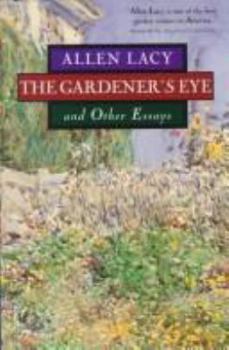The Gardener's Eye and Other Essays
Select Format
Select Condition 
Book Overview
In his third collection of essays, one of America's most thoughtful and engaging garden writers surveys the world with a gardener's eye. Like his highly acclaimed earlier collections, this work is... This description may be from another edition of this product.
Format:Paperback
Language:English
ISBN:080503952X
ISBN13:9780805039528
Release Date:January 1995
Publisher:Henry Holt & Company
Length:282 Pages
Weight:0.35 lbs.
Dimensions:0.8" x 5.5" x 8.2"
Related Subjects
Crafts & Hobbies Gardening Gardening & Landscaping Nature Science & Math TechnologyCustomer Reviews
1 rating
The gift of grace...
Published by Thriftbooks.com User , 23 years ago
Allen Lacy says the "gardener's eye" is comparable to a "gift of what Christians call grace--a gift that comes from outside, that is apart from one's own intentions." The gardener's eye is an artistic vision, an aesthetic experience, a recognition of beauty.Sometimes art is created by humans, mostly it comes from nature. He begins his book in winter, writing at the desk in his study. Looking out the window he notes "even in winter there is always something to see." Birds are about and the paulawnia bark is grey and stained green from the algae growing on the trunk. He can see the color and texture of the blackish bark on the White pine. In the next chapter, he remarks on the beauty of thistles, the bane of farmers and the emblem of Scotland. He says the Scottish thistle is impossible to ignore with it's outsized stem and leaves and it's ability to inflict pain. "My love affair with thistles has been going on for years. So have the visits from stangers who stop in the driveway and ask fo a closer look at these giants of the summer garden."A few miles away from Lacy's home is a garden filled with tall bearded Irises (German Irises). Named for the Greek Goddess of the rainbow, the irises are many hued. The hybridzers have done their job and created a palette of every color. At the appropriate moment every year he drives to the neighbor's garden to see the Irises in bloom. Page after page Lacy moves futher afield, past a cotton patch near Durham NC, to Middleton Place in South Carolina where the garden established in 1741 has become a point of horticultural pilgrimage for Americans and visitors overseas alike. Vita Sackville-West, she who built Sissinghurst, once traveled to this spot. "Stand I indeed in England? Do I dream?" she is reputed to have said.Lacy notes the Arends nursery in Germany, now run by his granddaughter Ursula Maubach is the source of the wonderful Astilbes found in many American gardens. There's A. taquettii 'Superba' with it's "tight, dense spikes" as well as pink 'Cattleya' and plumey 'Ostrich Feather.' Some of the Astilbes are fragrant, smelling like Jasmine.Lacy notes that every wise gardner should attend to Ms. Elizabeth Lawrence's works. Ms Lawrence gardened in Charlotte and Raleigh North Carolina, and was a trained horticulturist. Lacy himself has edited some of her material. He likens her writing to Henry David Toreau, Harriet Beecher Stowe, Lafcadio Hearn, Sarah Orne Jewett and Eudora Welty--another southerner and a friend. Lacy visits many places and at the end of his book returns to his study, where the autumn leaves are falling, the new school semester is beginning (he taught philosophy at Richard Stockton College for years), and his travels are over for the summer.




